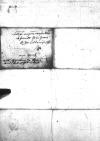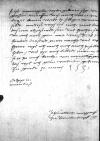Euer schreyben hab ich von Antwerp (Antwerpen, Antverpia), city in the Low Countries, from 1315 a Hanseatic port, in the 16th century the centre of Brabant’s artistic life and the wealthiest trade city in Europe, today in northern Belgium⌊AntorffAntwerp (Antwerpen, Antverpia), city in the Low Countries, from 1315 a Hanseatic port, in the 16th century the centre of Brabant’s artistic life and the wealthiest trade city in Europe, today in northern Belgium⌋ aus empfangenn und gyb euch zuerkennen, das Charles V of Habsburg (*1500 – †1558), ruler of the Burgundian territories (1506-1555), King of Spain as Charles I (1516-1556), King of Naples and Sicily, King of the Romans (1519-1530), Holy Roman Emperor of the German Nation (elected 1519, crowned 1530, abdicated 1556); son of Philip I the Handsome and Joanna the Mad of Castile⌊keyserliche maiestadtCharles V of Habsburg (*1500 – †1558), ruler of the Burgundian territories (1506-1555), King of Spain as Charles I (1516-1556), King of Naples and Sicily, King of the Romans (1519-1530), Holy Roman Emperor of the German Nation (elected 1519, crowned 1530, abdicated 1556); son of Philip I the Handsome and Joanna the Mad of Castile⌋ auf den montag hy verrucken wyrdt, sich in das closter pey Brussels (Bruxellae), city in the Low Countries, Duchy of Brabant, since the regency of Mary of Hungary the capital of the Habsburg Netherlands, today the capital of Belgium⌊BruesselBrussels (Bruxellae), city in the Low Countries, Duchy of Brabant, since the regency of Mary of Hungary the capital of the Habsburg Netherlands, today the capital of Belgium⌋ zu retrahieren. / Kan nimandt eygentlich wyssen, ab Charles V of Habsburg (*1500 – †1558), ruler of the Burgundian territories (1506-1555), King of Spain as Charles I (1516-1556), King of Naples and Sicily, King of the Romans (1519-1530), Holy Roman Emperor of the German Nation (elected 1519, crowned 1530, abdicated 1556); son of Philip I the Handsome and Joanna the Mad of Castile⌊seyn maiestedtCharles V of Habsburg (*1500 – †1558), ruler of the Burgundian territories (1506-1555), King of Spain as Charles I (1516-1556), King of Naples and Sicily, King of the Romans (1519-1530), Holy Roman Emperor of the German Nation (elected 1519, crowned 1530, abdicated 1556); son of Philip I the Handsome and Joanna the Mad of Castile⌋ wyder hy her komen were, / aber Francisco de los Cobos y Molina (*ca. 1477 – †1547), Andalucian nobleman born into the disadvantaged family of Diego de los Cobos, regent of Úbeda, and Catalina de Molina; 1503 scribe at the chancellery of Queen Isabella I of Castile; 1507 Treasurer of Granada; 1508 Regent for Úbeda, 1516 secretary to Charles I of Spain (later Emperor Charles V), Comendador for the Kingdom of Castile (KENISTON)⌊CovosFrancisco de los Cobos y Molina (*ca. 1477 – †1547), Andalucian nobleman born into the disadvantaged family of Diego de los Cobos, regent of Úbeda, and Catalina de Molina; 1503 scribe at the chancellery of Queen Isabella I of Castile; 1507 Treasurer of Granada; 1508 Regent for Úbeda, 1516 secretary to Charles I of Spain (later Emperor Charles V), Comendador for the Kingdom of Castile (KENISTON)⌋, Nicolas Perrenot de Granvelle (*1484 – †1550), doctor of both canon and civil law, one of the most trusted advisors of Emperor Charles V, in 1519 entered the service of Charles V, in 1521 took part in the Habsburg-French negotiations in Calais, in 1529 in peace negotiations with the Roman Curia and the Italian states, and later, in 1538, in the conference of Nice between Charles V and Francis I; prominent official and advisor of Charles V and of Margaret of Austria in the administration of the County of Burgundy and of the Habsburg Netherlands, collaborator of Chancellor Gattinara, 1530 secretary of State for German and Netherlandish affairs and Chancellor of the Kingdom of Sicily and Naples (he replaced Gattinara after his death in the position of Grand Chancellor, although not using the title); imperial envoy to France (several times up to 1528) (CE, vol. 3, p. 68-70; DURME 1964; ANTONY 2006)⌊GranbelaNicolas Perrenot de Granvelle (*1484 – †1550), doctor of both canon and civil law, one of the most trusted advisors of Emperor Charles V, in 1519 entered the service of Charles V, in 1521 took part in the Habsburg-French negotiations in Calais, in 1529 in peace negotiations with the Roman Curia and the Italian states, and later, in 1538, in the conference of Nice between Charles V and Francis I; prominent official and advisor of Charles V and of Margaret of Austria in the administration of the County of Burgundy and of the Habsburg Netherlands, collaborator of Chancellor Gattinara, 1530 secretary of State for German and Netherlandish affairs and Chancellor of the Kingdom of Sicily and Naples (he replaced Gattinara after his death in the position of Grand Chancellor, although not using the title); imperial envoy to France (several times up to 1528) (CE, vol. 3, p. 68-70; DURME 1964; ANTONY 2006)⌋, dan legatus et omnes oratores mit dem gantzem hoffgesindt beleyben hy und sein maiestadt nimbpt ser benig folgs mit sich, ut soleat cum fratribus habitare. / Etlich manen, er kum nit wyder her und las das hofgesindt hy, pis Charles V of Habsburg (*1500 – †1558), ruler of the Burgundian territories (1506-1555), King of Spain as Charles I (1516-1556), King of Naples and Sicily, King of the Romans (1519-1530), Holy Roman Emperor of the German Nation (elected 1519, crowned 1530, abdicated 1556); son of Philip I the Handsome and Joanna the Mad of Castile⌊sein maiestadtCharles V of Habsburg (*1500 – †1558), ruler of the Burgundian territories (1506-1555), King of Spain as Charles I (1516-1556), King of Naples and Sicily, King of the Romans (1519-1530), Holy Roman Emperor of the German Nation (elected 1519, crowned 1530, abdicated 1556); son of Philip I the Handsome and Joanna the Mad of Castile⌋ mit inen beschlesse der anferderung halben, / als dan mogen si al tag komen, woe dan keyserlich(en) maiestadt sein wyrdt. /So wyl ich dy heylige zeyt gen Brussels (Bruxellae), city in the Low Countries, Duchy of Brabant, since the regency of Mary of Hungary the capital of the Habsburg Netherlands, today the capital of Belgium⌊BruesselBrussels (Bruxellae), city in the Low Countries, Duchy of Brabant, since the regency of Mary of Hungary the capital of the Habsburg Netherlands, today the capital of Belgium⌋ czyhen, dan mir der lufft hye nicht seer wol gefeldt, / und euer herbring ist nit fast kostlich.
Wy ir dan von euerem diner vernemen werdt, / so ist der probably Balthasar Merklin von Waldkirch (*ca. 1479 – †1531), 1500 doctor of canon law at the University of Bologna; councillor at the imperial courts of Maximilian I and Charles V, 1527-1531 Vice-Chancellor of the Holy Roman Empire, 1527-1531 titular Bishop of Malta, Bishop of Hildesheim (confirmed in 1530) and coadjutor of the Bishop of Constance (confirmed in 1530) (NDB, Bd. 1, p. 566-567)⌊bischoff von Costnitzprobably Balthasar Merklin von Waldkirch (*ca. 1479 – †1531), 1500 doctor of canon law at the University of Bologna; councillor at the imperial courts of Maximilian I and Charles V, 1527-1531 Vice-Chancellor of the Holy Roman Empire, 1527-1531 titular Bishop of Malta, Bishop of Hildesheim (confirmed in 1530) and coadjutor of the Bishop of Constance (confirmed in 1530) (NDB, Bd. 1, p. 566-567)⌋ noch kranck. Wenzel Beyer (Payer, von Elbogen, Václav z Lokte, Venceslaus Cubitensis, Bayer) (*1488 – †1537), doctor of arts and medicine, professor in the faculty of medicine at the Leipzig university, author of several works, amongst others the first medical treatise upon term springs in Karlsbad (1521); 1530 stayed in Louvain; city physician in Elbogen (MOLANUS, p. 571; ADB, vol. 46 (1902), p. 535)⌊Doctor CubitoWenzel Beyer (Payer, von Elbogen, Václav z Lokte, Venceslaus Cubitensis, Bayer) (*1488 – †1537), doctor of arts and medicine, professor in the faculty of medicine at the Leipzig university, author of several works, amongst others the first medical treatise upon term springs in Karlsbad (1521); 1530 stayed in Louvain; city physician in Elbogen (MOLANUS, p. 571; ADB, vol. 46 (1902), p. 535)⌋ hadt probably Balthasar Merklin von Waldkirch (*ca. 1479 – †1531), 1500 doctor of canon law at the University of Bologna; councillor at the imperial courts of Maximilian I and Charles V, 1527-1531 Vice-Chancellor of the Holy Roman Empire, 1527-1531 titular Bishop of Malta, Bishop of Hildesheim (confirmed in 1530) and coadjutor of the Bishop of Constance (confirmed in 1530) (NDB, Bd. 1, p. 566-567)⌊imeprobably Balthasar Merklin von Waldkirch (*ca. 1479 – †1531), 1500 doctor of canon law at the University of Bologna; councillor at the imperial courts of Maximilian I and Charles V, 1527-1531 Vice-Chancellor of the Holy Roman Empire, 1527-1531 titular Bishop of Malta, Bishop of Hildesheim (confirmed in 1530) and coadjutor of the Bishop of Constance (confirmed in 1530) (NDB, Bd. 1, p. 566-567)⌋ ein benig wyder aufgeholffen und ist heudt hy weg gezogen. / So sel probably Balthasar Merklin von Waldkirch (*ca. 1479 – †1531), 1500 doctor of canon law at the University of Bologna; councillor at the imperial courts of Maximilian I and Charles V, 1527-1531 Vice-Chancellor of the Holy Roman Empire, 1527-1531 titular Bishop of Malta, Bishop of Hildesheim (confirmed in 1530) and coadjutor of the Bishop of Constance (confirmed in 1530) (NDB, Bd. 1, p. 566-567)⌊der von Costnitzprobably Balthasar Merklin von Waldkirch (*ca. 1479 – †1531), 1500 doctor of canon law at the University of Bologna; councillor at the imperial courts of Maximilian I and Charles V, 1527-1531 Vice-Chancellor of the Holy Roman Empire, 1527-1531 titular Bishop of Malta, Bishop of Hildesheim (confirmed in 1530) and coadjutor of the Bishop of Constance (confirmed in 1530) (NDB, Bd. 1, p. 566-567)⌋ auch uber zwen tag hy verrucken naufbarth zuczyhen weren permutierenn.
 AAWO, AB, D.90, f. 46v
AAWO, AB, D.90, f. 46v
So ist Mariangelo Accursio (Mariangelo Accorso) (*1489 – †1546), Italian humanist and poet, from 1521 majordomo, tutor and guide to Johann Albrecht and Gumpert of Brandenburg-Ansbach in Rome, in 1522 followed them in their travels to Poland, Germany, France and in visit to the Spanish court of Emperor Charles V, in 1532 he left Italy and the Hohenzollern's service and went to Augsburg, where he found hospitality in the circle of Anton Fugger; in 1533 he returned to Italy and settled in his home town of L'Aquila (CE, vol. 1, p. 4-5)⌊MariangelusMariangelo Accursio (Mariangelo Accorso) (*1489 – †1546), Italian humanist and poet, from 1521 majordomo, tutor and guide to Johann Albrecht and Gumpert of Brandenburg-Ansbach in Rome, in 1522 followed them in their travels to Poland, Germany, France and in visit to the Spanish court of Emperor Charles V, in 1532 he left Italy and the Hohenzollern's service and went to Augsburg, where he found hospitality in the circle of Anton Fugger; in 1533 he returned to Italy and settled in his home town of L'Aquila (CE, vol. 1, p. 4-5)⌋ wyder gekomen, sagt von grossen triumffen, versi mich, woe ir zw Brussels (Bruxellae), city in the Low Countries, Duchy of Brabant, since the regency of Mary of Hungary the capital of the Habsburg Netherlands, today the capital of Belgium⌊BruesselBrussels (Bruxellae), city in the Low Countries, Duchy of Brabant, since the regency of Mary of Hungary the capital of the Habsburg Netherlands, today the capital of Belgium⌋ komen werdt, dyselbigen vernemen hidden by binding⌈[en]en hidden by binding⌉ seldt. /
Andrest weys ich nichs neus elandt hidden by binding⌈[dt]dt hidden by binding⌉, das mir algesundt sein und horethen solch von euch auch gern. / Mit wunschung fil hunderdt dausendt gutter nacht und tag. Hymit wyl ich mich euch auch pefollen hidden by binding⌈[n]n hidden by binding⌉ haben. / Und pyt euch belledt mein wyrdt hidden by binding⌈[t]t hidden by binding⌉ , so er zu euch kombpt von meinetbege(n) grussen hidden by binding⌈[sen]sen hidden by binding⌉ das wyl ich gern verdinen.
 AAWO, AB, D.90, f. [1] after f. 46
AAWO, AB, D.90, f. [1] after f. 46


